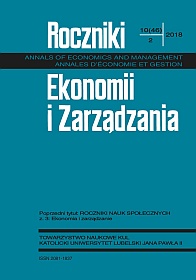The Shadow Area in the Tobacco Sector
Abstract
The shadow area is an illegal trade in legal goods and services. Poland is a significant producer of tobacco and tobacco products. The export of tobacco plays an important role in the balance of foreign trade. The tobacco industry is essential for the state budget due to a high share of indirect taxes on tobacco products in total budget revenues. In the structure of excise tax revenues, tobacco income amounts to around 28%. Due to the low base price of tobacco products and a large share of taxes in the price (around 80%), illegal production and smuggling of tobacco products is one of the most profitable activities of criminal groups. The aim of the article is to present the problem of the shadow economy in the tobacco industry and legal changes aimed at reducing it.
References
Allen E., The Illicit Trade in Tobacco Products and How to Tackle it, “World Customs Journal” 6(2011), No. 2, pp. 121-130.
Biuletyn Statystyczny Służby Celnej, 2011-2016
Eurobarometr, http://ec.europa.eu/commfrontoffice/publicopinion/archives/eb_special_439_420_en.htm#429 [dostęp: 06.2017].
EUROSTAT 2017, http://appsso.eurostat.ec.europa.eu [dostęp: 06.2017].
FAOSTAT 2017, http://www.fao.org/faostat/en/#data/QC [dostęp: 06.2017].
Handel zagraniczny produktami rolno-spożywczymi, red. W. Łopaciuk, Wydawnictwo IERiGŻ, Warszawa 2017.
Kabaj M., Praca nierejestrowana we współczesnej literaturze ekonomicznej, „Polityka Społeczna” 2009, nr 10, s. 3.
Kraciuk J., Szara strefa w Europie, „Zeszyty Naukowe SGGW” 2013, nr 1, s. 85.
Mackay J., Erixen M., The Tobacco Atlas, World Health Organization 2002.
Metodologia badań szarej strefy na rynku usług turystycznych, red. T. Smuga, Instytut Koniunktur i Cen Handlu Zagranicznego, Warszawa 2005.
Mika B., Wszystkie odcienie szarości, w: Struktura klasowo-stanowa społeczności Poznania, red. J. Tittenbraun, Poznań 2010.
Piętka K., Szara strefa jest w świetnej formie, „Puls Biznesu”, 12.03.2004.
Poland Market Survey Top Lines Empty Discarded Pack Collection October/November 2016,Almares, Warszawa.
Przeciwdziałanie szarej strefie w Polsce, Global Compact Network Poland, http://ungc.org.pl/programy/program-przeciwdzialanie-szarej-strefie-2014-2020 [dostęp: 03.03.2018].
Rachunki narodowe według sektorów i podsektorów instytucjonalnych w latach 2012-2015, Główny Urząd Statystyczny, Warszawa 2017.
Rocznik Statystyczny Rzeczpospolitej Polskiej, GUS 2010-2015, Warszawa.
Rynek wyrobów tytoniowych – stan i perspektywy, red. M. Bodył, Wydawnictwo IERiGŻ, Warszawa 2017.
Schneider F., Ernest H.D., Shadow Economies: Size, Causes and Consequences, „Journal of Economic Literature” 38(2000), s. 77-114.
Skutki wdrożenia dyrektywy tytoniowej, red. R. Gwiazdowski, Centrum im. Adama Smitha, Warszawa 2013.
Copyright (c) 2018 Roczniki Ekonomii i Zarządzania

This work is licensed under a Creative Commons Attribution-NonCommercial-NoDerivatives 4.0 International License.


